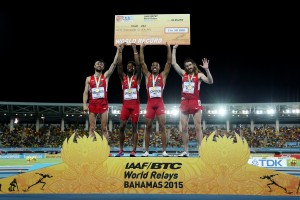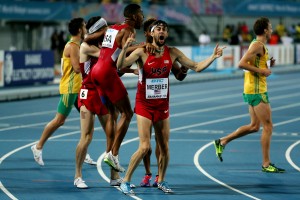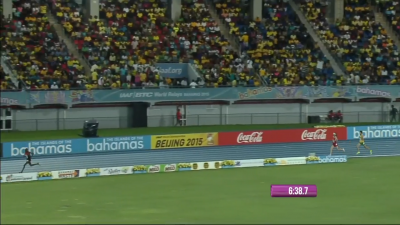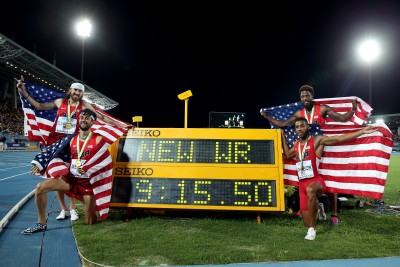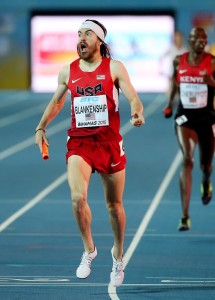USA “Motley Crew” Caps Distance Relay Sweep With Wild World-Record Victory In Men’s DMR – 9:15.50 In A Crazy Race
By LetsRun.com
May 3, 2015
NASSAU, Bahamas — In the end, after this the crazy men’s distance medley relay was over, the US motley crew of Kyle Merber (1,200), Brycen Spratling (400), Brandon Johnson (800) and Ben Blankenship (1,600) were not only your gold medalists, but your world record holders as they ran an impressive 9:15.50, just under the old mark of 9:15.56, to win gold as Kenya got the silver in 9:17.20 and Australia bronze in 9:21.62.
There was a ton of excitement on the way to the world record as there were two crazy legs run in this one by the Kenyans. The legs were so crazy and run with so much reckless abandon that they reminded us of a high school clash we used to see in a Millrose Games high school race at the Garden, not a fully professional race on the IAAF circuit. This was the race of the World Relays for us. We break it down below.
The Race
The opening leg was pretty much your standard 1200 leg on a DMR. You can’t win a DMR on the 1200 but you can lose it, and none of the major players lost it on the opening leg. Every team except for Papua New Guinea jogged around for two laps in 2:00 before getting things going on the last lap. In the end, 3:31 man Ryan Gregson of Australia handed off in the lead after a 2:53.15 to Kyle Merber’s 2:53.56 for the US. Kenya’s inexperienced 32-year-old Abednego Chesebe (All-Athletics lists no results for him prior to 2012) who has a 3:35 pb, led most of it until the last lap where he barely kept things close enough for Kenya by handing off in third in 2:54.48.
On the 400 leg, the surprise was that the best split came from Kenya as 20-year-old Alphas Kishoyan split 45.48 as the top three teams of Australia, the US and Kenya were separated by just .98.
On the 800, Kenya got the baton in third, some .98 back, but they soon were in the lead as Kenya’s 1:42 man, Ferguson Rotich Cheruiyot went out INCREDIBLY fast. He blew by the US’s Brandon Johnson, who possesses a 1:43 pb, like he was standing still. Soon Rotich Cheruiyot’s lead was roughly 10 meters.
What the hell was going on?
Well Rotich Cheruiyot was going out in an 800 faster than we’ve ever seen anyone go out (Editor’s note: Possibly faster than anyone has ever gone out – MB: fastest 400 split for 800m). When David Rudisha set the 1:40.91 world record at the 2012 Olympics, he went out in 49.28. Tonight, Rotich Cheruiyot split 47.84. Yes 47.84. Even with a running start, this was suicidal.
The bear jumped on Rotich Cheruiyot’s back during the final 200 as Johnson (who went out in 49.06) tied up the least. In the end, the US, Kenya and Australia all handed off very close together as Johnson split 1:44.75, Rotich Cheruiyot 1:44.49, and Villanova’s Jordan Williamsz split 1:45.65. Heading into the anchor, the US and Ben Blankenship (3:35 pb) led by .19 over Kenya and 19-year-old Timothy Cheruiyot (1:45/3:36 pbs) with Australia and Collis Birmingham (3:35 pb) another .17 back.
The race was on as three teams were together to start the anchor.
In our race preview, we wondered if Timothy Cheruiyot might be poised to be Kenya’s next great teen sensation, much like Ronald Kwemoi last year. Within the first 200, it was clear to us that Mr. Cheriuyot is indeed a SUPREME talent. He blew by Blankenship.
However, another thing was very clear, Tim Cheruiyot is very inexperienced. This was his first race ever outside of Kenya (despite winning the Kenyan 1500 Trials for this) and it showed.
Before the first lap was over, he had close to a 25-meter lead. We thought we’d seen it all at the start of 800 leg just a few minutes before but this was at another level. Going out insanely fast in an 800 is one thing, doing in a 1600 is a whole other level of stupidity.
Cheruiyot ran the first lap in 51.96. Blankenship judged things much better and went out in 55.27. Cheruiyot obviously slowed on lap two but his lead still grew as he ran a 58.65 to Blankenship’s 59.27. Cheruiyot’s pacing mistake on lap #1 started to cost him on lap #3 as he only managed a 62.19 to Blankenship’s 59.90. Kenya’s lead was down to just 10 meters (1.55 seconds). It was clear that Cheruiyot would be caught. The only question that remained is would he somehow respond?
Blankenship went by Cheruiyot with about 230 meters to go. It took a second for Cheruiyot to respond but he dug deep and tried to latch on to Blankenship as they entered the final turn. If Cheruiyot somehow was going to defy the laws of physiology and will himself to victory in this one, we were going to call it the greatest (but most foolish) relay leg we’ve ever seen. But in the end, Blankenship pulled away and won thanks to a 56.80 final lap (Cheruiyot ran a 59.95) that gave him a very nice 3:51.24 1600 split, running most of it all alone. Cheruiyot’s 1600 split was 3:52.75.
The US had run a tremendous race and was rewarded with the world record and a sweep of the distance races at the 2015 World Relays.
Results, and post-race analysis below.
| 1 | USA | UNITED STATES |  USA USA |
9:15.50 | WR | 8 | |
| 2 | KEN | KENYA |  KEN KEN |
9:17.20 | 7 | ||
| 3 | AUS | AUSTRALIA |  AUS AUS |
9:21.62 | 6 | ||
| 4 | POL | POLAND |  POL POL |
9:24.07 | 5 | ||
| 5 | GER | GERMANY |  GER GER |
9:24.37 | 4 | ||
| 6 | PNG | PAPUA NEW GUINEA |  PNG PNG |
10:50.63 | 3 |
USA splits
1200: Merber 2:53.56
400: Spratling 45.95
800: Johnson 1:44.75
1600: Blankenship 3:51.24 (55.27-59.27-59.90-56.80)
Kenya splits
1200: Chesebe 2:54.58
400: Kishoyan 45.48
800: Ferguson Rotich Cheruiyot 1:44.49 (47.84-56.65)
1600: Tim Cheruiyot 3:52.75 (51.96-58.65-62.19-59.95)
Quick Take #1: This Was an Awesome Race – i.e. races are more interesting when runners go out crazy fast
Ferguson Rotich Cheruiyot on the 800 probably cost Kenya a little time after going out in 47.84 on his leg, though he didn’t kill the Kenyans’ chances at victory. Though he slowed badly at the end of his leg, he still split an impressive 1:44.49 and handed off in second, .19 of a second behind the Americans. If he goes out in 49.0, he probably runs between .5 and 1.5 seconds faster for his leg. That would have helped Tim Cheruiyot on the anchor, but it’s impossible to say if it would have changed the outcome.
Given his 1:45 pb that he set last year at age 18, Tim Cheruiyot got the baton in a perfect spot — right behind the leader. The strategy for an inexperienced 1500m man like Tim Cheruiyot seemed simple to us: run behind Blankenship and Birmingham for 3.5 laps and then try and blow their doors off like Jordan Williamsz did with Edward Cheserek in the 4xmile at Penn last week.
Instead, Tim Cheruiyot not only decided to lead, he tried to win the race in the first lap. He clearly made a huge mistake going out so fast on the anchor leg (51.96). 55 is plenty fast in a 1500. If both Rotich and Cheruiyot ran more even splits, Kenya would have almost certainly been your winners tonight.
Tim Cheruiyot’s English isn’t great but he said of the opening lap, “I was trying my best and I was trying to set the pace.”
Both Rotich and Cheruiyot chose to go out super-fast, and it made the race a classic. Most American fans are accustomed to a tactical anchor leg on the DMR, and even if the anchor leg isn’t tactical, you never see a race like this, where an 800 leg goes out in 47.84 and a 1600 leg goes out in 51.96.
Tactical anchors can be exciting too, but this was a different kind of drama. Because the DMR is so rarely-run on the professional stage — and because this race was run in such a unique way — no one knew what was going to happen at the end of the race. And races are always more exciting when nobody knows what’s going to happen.
As we said above, the Kenyans reminded us of what we used to see sometimes at Millrose in the Garden in the high school races. Most seasoned pros — hell, even collegians — run sensible races, judging their pace correctly before kicking at the end. Occasionally in high school races, particularly on a relay or say in a race at the Garden, you’d see HSers just race each other throwing caution to the wind. That’s what tonight’s DMR was like.
Quick Take #2: Ben Blankenship Executed Perfectly and the Americans should buy Kenyan anchor Timothy Cheruiyot a beer
Once Blankenship received the baton on the anchor leg, he did something important. He looked at Cheruiyot in the eye, and then motioned for Cheruiyot to take the lead. Cheruiyot took the bait, but there is no way Blankenship could have anticipated Cheruiyot going out in 51.96. Instead of having a rabbit, Blankenship was all alone.
Blankenship said he had worked out hand signals with coach Vin Lananna beforehand in case he was in ‘no man’s land’ like Shannon Rowbury in the women’s DMR the night before. Blankenship thought if anything he might be in front all alone and he wanted to make sure if he was alone that Lananna could signal him some sort of concept of pace. That preparation proved valuable here as Blankenship had to run a very fast split to get the win. Cheruiyot went out crazy fast, but he held up amazingly well.
Blankenship has been running well this year, and showed that tonight running a confident, intelligent leg, always keeping his eyes on the win even when it would have been easy to settle for second. Blankenship produced a performance that was right in line with his 3:53.13 mile pb (set indoors this year in Boston) as he went 55.27-59.27-59.90-56.80 to split 3:51.24 — a very fast time in windy conditions. Winning (and setting the world record) tonight was going to take a massive performance, and Blankenship and all the Americans delivered, sealing not only the win but a U.S. sweep of the distance relays.
Cheruiyot deserves a beer because there’s no way the anchors run that fast and any chance of a WR goes out the window if Cheruiyot didn’t take the lead. The final leg could have easily settled into a tactical affair. Instead, that .06 of a second that the U.S. sliced off the world record is worth $50,000 — an extra $12,500 apiece for Merber, Spratling, Johnson and Blankenship.
Blankenship Talks of His Gold and the Hand Signals:
Ben said when Cheruiyot went out crazy fast his thinking was “Just hang in there and weather the storm.”
Blankenship is running great this year and when asked what was different he said, “(the) Background, (I have) a lot of miles in my legs now and a lot of work behind me. I think (coach Mark Rowland and I have a really great plan going forward. I’m really grateful to be working with Mark Rowland going forward and having the support of Nike behind me.”
Quick Take #3: Great legs by the U.S. distance guys
Spratling split wasn’t the fastest, a 45.95 split (he split 45.2 last week at Penn), but he did run a race yesterday (splitting 45.78 in the 4×400 prelims) so all in all, he didn’t run too badly. Merber looked good handing off in second thanks to a 2:53.56 1200 leg (53.28 final lap) and Johnson redeemed a poor performance last year (1:48.1 split in the 4×800) by running a terrific 1:44.75 and handing off in first. Johnson’s time was identical to Erik Sowinski’s in the 4×800 last night (the fastest split of any runner in the 4×800) and it’s more proof that he’s on his way back to his 2013 form after a rough 2014 (he explains last year’s struggles in this LRC one-on-one interview from January).
Interestingly, coach Vin Lananna, who joked afterwards he should retire as a coach after the US men won both distance races here, said he let the five 800 runners pick which race they wanted to run based on the times they had run this year. The four fastest guys opted for the 4×800 so that left Johnson for the DMR and he more than delivered.
Kyle Merber also said the Lananna told him not to hand off in first unless he was way in front as he wanted Spratling to be chasing. Not a strategy we’ve heard before but it definitely worked.
Quick Take #4: Rotich and Cheruiyot are incredibly tough
Rotich and Cheruiyot may have run stupidly, but nobody can fault their toughness — or bravery. Their final splits of 1:44.49 and 3:52.75 are impressive on their own, and doubly so considering how quickly they went out. Both had to be hurting badly during the second half of their legs, but they gutted it out and Kenya almost won the race despite some horrendous tactics.
They both ran very good times despite going out faster than we’ve ever seen anyone go out before. The USA had to run a nearly perfect race to win gold and to break the world record.
Quick Take #5: The US “B” or “D”? Team Gets Gold
This was not the United States’ “A” 1500m team and shows the depth in America. Medallists Leo Manzano and Matt Centrowitz opted not to run which opened up a spot for Blankenship on the anchor. Johnson ran the 800 because the other 800 guys opted to run the 4×800. Spratling ran yesterday in the 4×400 but got bumped to this race. Brandon Johnson is the only member of this team who has run individually at Worlds. Despite the motley nature of the team, Kyle Merber knew the world record was a possibility before hand and calculated out what each person needed to do. When the race went out in 2:00, many might have thought the world record was gone, but Merber focused on bringing it home fast and ran a very impressive 53.28 third lap.
Merber talked about this “B” team breaking the world record (and joked about it being the USA’s “D” team). He said, “I know it’s not the ‘A’ team. It’s a good team. It’s a testament for our depth. No one [except for] Brandon has made a World’s team in 2013 for the 8[00]. None of us have besides that [have made a Worlds team] and we came together and did a world record. It just shows the US is deep. We have a lot of moveable parts we can put in at almost any distance and get it done.”
What an amazing performance:
Quick Take #5: Will Kenya (or Ethiopia) think about bringing full-strength (or at least, stronger) teams to the next World Relays in 2017?
Kenya dominated the distance races in 2014, winning the men’s 4×800, men’s 4×1500 and women’s 4×1500. Those victories are financially enticing for athletes ($50,000 for the win), especially when you can set a world record, which is worth an extra $50,000 (Kenya set WRs in both 4x1500s last year). This year, it sent mostly young, unproven athletes. The men’s DMR was probably its most talented team, but even that could have been better were it not for the withdrawals of two-time World 1500 champ Asbel Kiprop (who cited injury) and 3:28 man Ronald Kwemoi (who gave no reason for his withdrawal although there is some speculation which has been denied by the runners that they skipped out to stick it to Atheltics Kenya for suspending their agents).
The U.S. squads weren’t the best they could be, either (Leo Manzano and/or Matthew Centrowitz on paper could have helped this team, but Blankenship ran tremendously well), but the Americans took this meet more seriously than the Kenyans and it showed in the medal table.
The World Relays is quickly becoming one of the highlights of the track and field calendar. The atmosphere in the Bahamas was once again terrific, and it is great for US distance fans to watch the US distance runners celebrate golds and world records. But that doesn’t mean there’s still not room for improvement. Step 1 is getting more countries to buy in to the meet, and in the distance races, that begins with Kenya sending better teams and Ethiopia sending a team, period.
Video Highlights:

